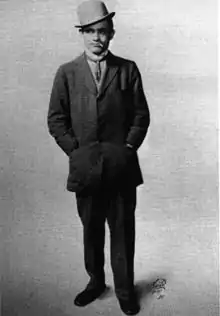Elmer Booth
William Elmer Booth (December 9, 1882 – June 16, 1915) was an American stage and film actor. He was born in Los Angeles, California and was the elder brother of Margaret Booth, a renowned film editor for Hollywood productions for nearly 70 years.[1]
Elmer Booth | |
|---|---|
 Booth as Jack Doogan in the 1913 play Stop Thief! | |
| Born | William Elmer Booth December 9, 1882 Los Angeles, California, U.S. |
| Died | June 16, 1915 (aged 32) Los Angeles, California, U.S. |
| Occupation | Stage and film actor |
| Years active | 1901–1915 |
| Spouse(s) | Irene Outtrim (m. 1908) |
| Children | 1 |
| Relatives | Margaret Booth (sister) |
Career
Elmer began acting in touring stock companies as a teenager and achieved great success in the stock company at the Central Theater in San Francisco from 1903-1906. Between 1910 and 1915 he starred in 40 movies; one of those was D. W. Griffith's The Musketeers of Pig Alley (1912), cited by many film experts as the first gangster movie.
Playing "The Snapper Kid", a Manhattan street tough engaged in a turf war on the Lower East Side, Booth interpreted the gangster as a cocky, entertaining antihero, far different from the standard teeth-gnashing movie bad guys of his time.[2]
Death
In the early hours of June 16, 1915, Booth died in an accident in California while riding in a car driven by Tod Browning, an actor and new director with Reliance-Majestic Studios in Hollywood.[3] Actor George Siegmann was also a passenger in Browning's car. The day after the accident, the Los Angeles Times reported that the three men were returning to downtown Los Angeles from a roadhouse when Browning's car crashed into a train of the Salt Lake Railroad:
Elmer Booth was killed instantly. The motor car in which he was speeding towards Los Angeles with his two companions rammed the rear part of a flat car loaded with steel rails at Santa Fe avenue and Salt Lake tracks early yesterday morning. The conductor of the train, Harry Jones, approaching, had waved his lantern as a danger signal, and then had come to the crash that sent Elmer Booth, who was just realizing his dramatic ambitions, headforemost into the rails.[3]
Browning and Siegmann survived, although they both suffered serious injuries.[3][4] Later reports blamed the accident on heavy fog; nevertheless, Elmer's sister Margaret never forgave Browning for the loss of her brother.[4][5]
D. W. Griffith, who had planned to cast Booth in an important role in Intolerance, delivered the actor's graveside eulogy.[2]
Personal life
Booth married actress Irene Outtrim in 1908. That same year, their son was born; he would die of pneumonia in March 1910.[6]
Selected filmography
- A Beast at Bay (1912)
- An Unseen Enemy (1912)
- The Musketeers of Pig Alley (1912)
- Gold and Glitter (1912)
- The Adopted Brother (1913)
- Mrs. Black is Back (1914)
- Gasoline Gus (1915)
- A Chase by Moonlight (1915)
References
- Brownlow, Kevin (1968). The Parade's Gone By. Ballantine Books. p. 342.
- Edwards, Bobb (n.d.). Elmer Booth at Find a Grave. Ancestry.com, Lehi, Utah.
- "Investigating Ride to Death", Los Angeles Times, Pictorial City Sheet II, June 17, 1915, p. 1. ProQuest Historical Newspapers
- "Elmer Booth Killed",Moving Picture World, July 3, 1915, p.75. Internet Archive, San Francisco, California. Retrieved November 18, 2019.
- Ska, David J. (2001). The Monster Show: A Cultural History of Horror. Macmillan. p. 35. ISBN 978-0571199969.
- https://www.newspapers.com/clip/34637151/tragic-death-of-the-child-of-irene/
